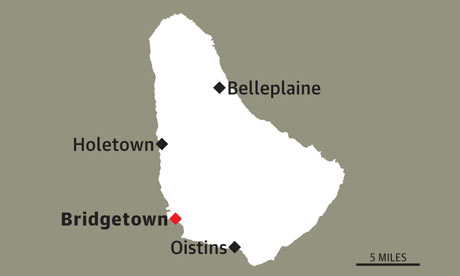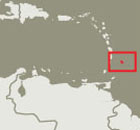About Barbados
Saturday, April 18, 2009
From http://www.guardian.co.uk/country-profile/barbados
Country profile: Barbados
Facts and statistics on Barbados including history, population, politics, geography, economy, religion and climate
- The Guardian, Saturday 18 April 2009
- Article history

Map of Barbados. Source: Graphic
Potted history of the country: With Caribs long gone from Barbados, British settlers found the island uninhibited on their arrival in 1627. The demand for sugar, rum and molasses made it a common destination for slaves, and the industries flourished long after the abolition of slavery in 1834. The nation retains a strong British culture, four decades after independence in 1966.
- At a glance
- Location: The most easterly of the Caribbean islands
- Neighbours: Trinidad
- Size: 166 square miles
- Population: 273,987 (180th)
- Density: 1,650.5 people per square mile
- Capital city: Bridgetown (population 116,000)
- Head of state: Queen Elizabeth II
Head of government: Prime minister David Thompson - Currency: Barbados dollar
- Time zone: Barbados time (-4 hours)
- International dialling code: +1 246
- Website: barbados.gov.bb
- Data correct on Saturday 18 April 2009
Political pressure points: The prime minister, David Thompson, in power since January 2008, won a no-confidence vote in March over his handling of a financial crisis involving the troubled insurer CLICO. The Barbados Labour party had accused him of masking the extent of an emergency that threatens jobs and pensions.
Population mix: African-Caribbean 80%, European 4%, mixed 16%
Religious makeup: Protestant 36%, Catholic 3%, Muslim 1%
Main languages: English
Living national icons: Kamau Brathwaite (writer), George Lamming (writer), Rihanna (singer), Sir Garry Sobers (cricketer, retired), Obadele Thompson (athletics)
 Barbados on a map. Source: Graphic
Barbados on a map. Source: Graphic
Landscape and climate: Almost completely encircled by coral reefs, the easternmost Caribbean island's position, tropical climate and gently sloping limestone plains make it fertile growing ground for sugarcane, which covers about 80% of the island's surface. The wet season runs from June to November and the dry season from December to May.
Highest point: Mount Hillaby 336 metres
Area covered by water: Less than one square mile
Healthcare and disease: Occasional outbreaks of Dengue fever are among the few concerns on an island that has some of the best healthcare facilities in the region. The government is funding a $90m (£64m) programme to reduce the country's prevalence of HIV nearer the Caribbean average of 1.2%.
Average life expectancy (m/f): 72/78
Average number of children per mother: 1.5
Maternal deaths per 100,000 live births: 16
Infant deaths per 1,000 births: 12
Adults HIV/Aids rate: 1.5%
Doctors per 1,000 head of population: 1.2
Adult literacy rate: 99.7% (m 99.7%/f 99.7%)
Economic outlook: The end of the construction boom has hurt the tourism industry, and foreign exchange earnings have suffered as offshore banking activities have slowed. The government has committed to stronger trade ties with China.
Main industries: Tourism, banking, insurance, rum
Key crops/livestock: Sweet potatoes, coconuts, poultry
Key export: Rum
GDP: £1,752m (145th)
GDP per head: £5,980
Unemployment rate: 9.8%
Proportion of global carbon emissions: 0.01%
Most popular tourist attractions: Enterprise beach, one of the most popular white-sand beaches, the Andromeda botanic gardens
Local recommendation: A tour of the 350-year-old Sunbury Plantation House, 25 minutes from Bridgetown in the St Philip countryside
Traditional dish: Coucou (cornmeal and okra paste) and flying fish
Foreign tourist visitors per year: 547,534
Media freedom index (ranked out of 173): n/a
Did you know ... Road tennis, originally played on quiet streets with a wooden paddle and a de-fuzzed tennis ball was invented on the island.
National anthem:
We write our names on history's page
With expectations great
Strict guardians of our heritage
Firm craftsmen of our fate
· Information correct on date of first publication, Saturday 18 April 2009.
Labels: Andromeda Gardens, Barbados, Bridgetown, Carib, Caribbean, flying fish, Mt. Hillaby, plantations, Rihanna, rum, slave, St. Philip, sugar, Sunbury Plantation, tropical


